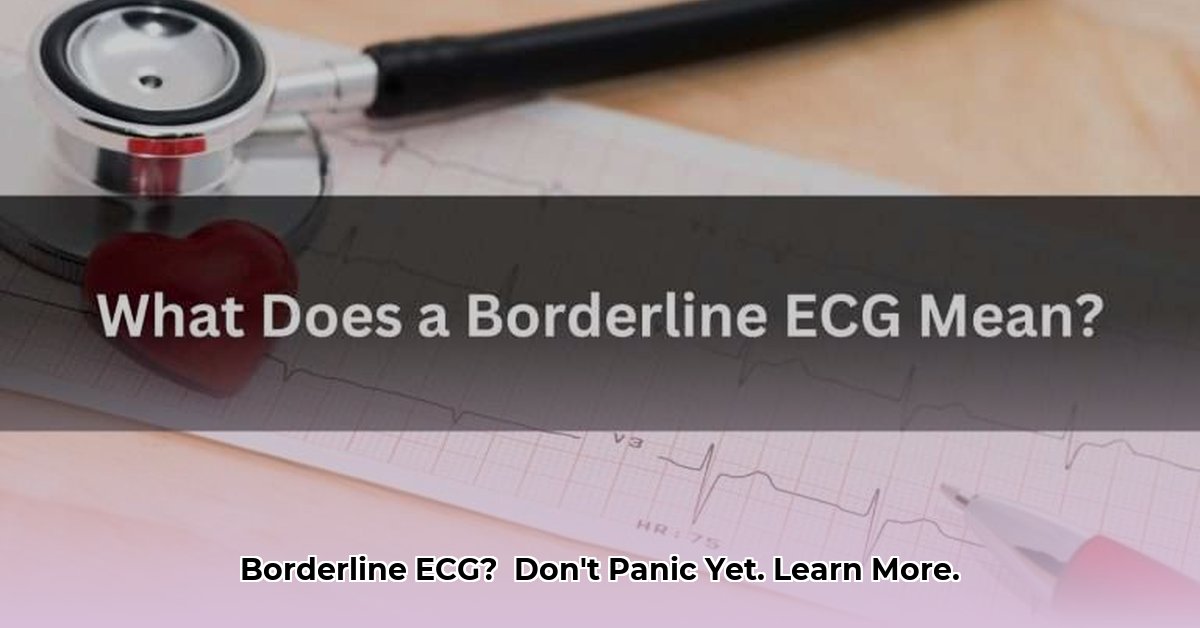So, your ECG results came back “borderline.” Understandably, this can be a little unsettling. This guide is designed to help you navigate this uncertainty. We’ll explore what “borderline” actually means in the context of an ECG, discuss possible causes, and outline the next steps you can expect. Think of this as your roadmap to understanding your heart health a little better.
Decoding “Borderline” ECG Results
An electrocardiogram (ECG) is a snapshot of your heart’s electrical activity. A “borderline” ECG doesn’t mean you have heart disease. It simply means some readings fall slightly outside the typical range, raising a flag for further investigation. It’s like a slightly blurry photograph – you get the general idea, but you need a sharper image to see the details.
What Might Cause a Borderline ECG?
Many factors can contribute to a borderline ECG, some completely harmless and others potentially more significant. Here are a few possibilities:
- Lifestyle Factors: Smoking, dietary habits, exercise levels—these lifestyle choices can subtly influence heart rhythms and may result in borderline ECG findings.
- Stress and Anxiety: Stress hormones can temporarily alter heart rate and rhythm, sometimes enough to produce readings outside the normal range.
- Medications: Certain medications, even common over-the-counter ones, can impact heart rhythms and ECG readings. Always inform your doctor of all medications you are taking.
- Electrolyte Imbalances: Electrolytes, like potassium and magnesium, are critical for regular heartbeats. An imbalance can sometimes lead to a borderline ECG.
- Underlying Heart Conditions: In some cases, a borderline ECG may be an early indicator of a developing heart condition, such as coronary artery disease or a minor heart valve issue. However, further testing is essential to confirm this.
- Heart Rhythm Variations: Minor irregularities in heart rhythm, like premature atrial contractions (PACs) or premature ventricular contractions (PVCs), are relatively common and can sometimes lead to borderline ECG results. Often, these are benign, especially in otherwise healthy individuals.
- Technical Factors: Occasionally, a borderline reading is simply due to a technical factor, such as electrode placement or slight movement during the recording. Dense breast tissue in women can occasionally affect the clarity of the ECG.
Specific Borderline ECG Findings
Certain parts of the ECG waveform may be flagged as borderline. Let’s break down a few key areas:
QT Interval
The QT interval measures the time it takes for your heart’s ventricles (lower chambers) to contract and recharge. A borderline QT interval may suggest a slightly increased risk of certain irregular heartbeats (arrhythmias), but it doesn’t mean you’ll definitely develop them.
ST Segment
The ST segment reflects the period between ventricular contraction and relaxation. A borderline ST segment might indicate very subtle changes in blood flow to the heart muscle, sometimes linked to very early stages of coronary artery disease. This requires further evaluation.
T Wave
The T wave shows the heart’s electrical reset. A borderline T wave could be related to minor electrolyte imbalances or other, less common underlying factors.
Next Steps After a Borderline ECG
A borderline ECG is not a diagnosis; it’s a signal that more investigation is needed. Your doctor might recommend the following:
- Repeat ECG: A second ECG can help determine if the initial findings are persistent or were a one-time occurrence.
- Echocardiogram: This ultrasound of the heart shows its structure and function in detail, helping to assess heart valves, chambers, and overall pumping efficiency.
- Stress Test: A stress test, often done on a treadmill, evaluates your heart’s response to physical exertion, assessing blood flow and identifying potential blockages.
- Holter Monitor: This portable device records your heart’s rhythm for 24-48 hours, detecting intermittent irregularities that a standard ECG might miss.
- Blood tests: These can check for electrolyte imbalances, assess cholesterol levels, and evaluate other factors that might be influencing heart health.
Coping with Uncertainty
Waiting for further tests and results can be stressful. Try these strategies:
- Open Communication: Talk to your doctor about your concerns. Understanding the process and having your questions answered can greatly reduce anxiety.
- Healthy Lifestyle: Focus on controllable factors, like regular exercise, a balanced diet, and stress management techniques (such as deep breathing and meditation). These benefit overall health, including heart health.
- Support System: Lean on friends, family, or support groups. Sharing your concerns can be incredibly helpful.
Frequently Asked Questions (FAQ)
Q: Is a borderline ECG serious?
A: Not necessarily. It often reflects temporary factors or normal variations. However, further evaluation is crucial to rule out any underlying heart conditions.
Q: What does a borderline ECG mean?
A: It means certain aspects of your heart’s electrical activity are slightly outside the typical range, not severely abnormal.
Q: What causes a borderline ECG?
A: Many factors, including individual variations, stress, medications, electrolyte imbalances, or possibly underlying heart conditions.
Disclaimer: This information is for educational purposes only and doesn’t replace professional medical advice. Always consult a qualified healthcare professional for any health concerns or before making decisions about your health or treatment.
- Bento Box Trays Streamline Restaurant Meal Presentation and Transport - December 13, 2025
- Plastic Bento Boxes Face Scrutiny Over Sustainability Impacts - December 11, 2025
- Bento Tray Revolutionizes Organized Meal Transport and Presentation - December 10, 2025










